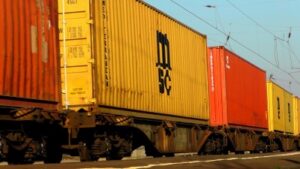Road vs. Rail Freight Transport: Pros and Cons of Each
Posted on January 10, 2022 Did you know that over 1.5 billion tons of materials and goods are transported by rail freight transport? One of the biggest debates that have arisen since the COVID-19 pandemic is which mode of transportation is the most reliable?
Did you know that over 1.5 billion tons of materials and goods are transported by rail freight transport? One of the biggest debates that have arisen since the COVID-19 pandemic is which mode of transportation is the most reliable?
The world became used to one-day shipping and quick delivery options. Now, the global supply shortage has sent many manufacturers searching for other options. The road vs. rail freight transport debate has ensued as ports become jam-packed.
If you have an interest in learning more about the difference between these two transportation options, then keep reading on.
Transportation Options
When it comes to transporting goods, there are four main options out there: road, rail, sea, and air. The global supply chain has been greatly impacted by the COVID-19 pandemic. Many container ports are either shut down or lagging behind the skyrocketing demand for goods.
Shipping from other countries to America typically requires transport by sea or air. This is where the majority of the supply chain becomes disrupted. What about transporting goods across the country or into Canada?
Road and rail freight transportation become the easiest and most reliable methods but both have their pros and cons.
Road Transportation
Road transportation is great for short and quick methods of transporting various goods. Typically, large trucks work at delivering packages and products across various parts of the country in a timely manner.
However, adverse weather such as rain, snow, and wind can lengthen trips and cause delays. If there are major traffic incidents or closed roads, then your truck driver might be delayed by more than just a few hours.
It tends to be cheaper and the easiest option for simple wholesale items. Road transportation can also deliver to more rural parts of the nation. This makes it an ideal option for people whose stores and houses are not along major roadways.
Rail Freight Transportation
For longer transportations, rail freight is the option to go with. Not only can it be more reliable than other methods of transport, but it is also a greener option.
This has received the most recent spotlight in the news. Transportation of goods creates high amounts of deadly emissions each year. However, it is a crucial part of connecting manufacturers, businesses, and local residents.
Some statistical reports show that greenhouse gas emissions would be reduced by over 13 million tons through rail systems. This would happen if at least one-quarter of trucks traveling over 750 miles switched to rail transport.
Transitioning to rail freight transportation can also help save fuel, time, and money. It provides greater safety for workers by avoiding dangerous roads and adverse weather. The schedules are typically set so that you can expect shipments through a reliable schedule.
On the flip side, it is not as realistic for short transports and could be more time-consuming and costly for short journeys. Delivering directly to rural parts of the country could also prove to be another challenge.
Road vs. Rail Freight Transportation
So – which one has the upper edge? Rail freight transport provides less weight and cargo restrictions. This is great news for manufacturers transporting heavy goods and materials.
Additionally, all of the cargo can be carried in one trip. You also avoid different state regulations versus carrying the same goods by road. Currently, it is one of the fastest modes of transportation since the COVID-19 pandemic affected air and sea vessels.
It is also easier to track deliveries by rail since they can run on set schedules and have GPS attached to them. Two of the big distinguishing factors between road and rail transport are where you are delivering goods or cargo and how short the distance is.
If you want goods transported within your own state and in rural communities, then road transport can be more beneficial. Keep in mind – this is largely the only positive outcome between road vs rail. In all other scenarios, rail transport allows greater flexibility.
Future of Cargo Transportation
Where does the future of transportation lay? Before the COVID-19 pandemic, sea vessels were one of the main modes of transport. Now, it can take up to 10 days for a ship to dock.
Air transport has also been affected and can face stricter regulations on the types of goods transferred. On land, road transport faces tighter scrutiny as many workers are quitting or not enough truck drivers are filling positions.
With winter looming ahead, it makes it even more crucial to have adequate truck drivers to meet the needs of Christmas deliveries. Rail freight transportation largely remains unaffected by the chaos of other modes of transportation.
Technology such as drones and anti-crash monitoring are helping keep rail workers and cargo safer. GPS has also improved to the point of accurately tracking deliveries via the rail system.
Ultimately, the rail system has evolved since its early days in striving to meet users’ needs in a more reliable and efficient manner. This is largely why predictions show a 40% increase in demand over the course of the next two decades.
Rail Freight Transport
There are many pros and cons between road vs. rail freight transportation, but rail freight provides a cheaper, more reliable, and energy-efficient option.
Keeping workers and the environment safe is one of the top priorities of railways and employers working in this industry. Companies that offer professional installation of rail siding can help improve the safety and efficiency of rail systems.
Contact us today and get a quote on the installation of rail siding and how it can promote improvements in the rail freight industry.



